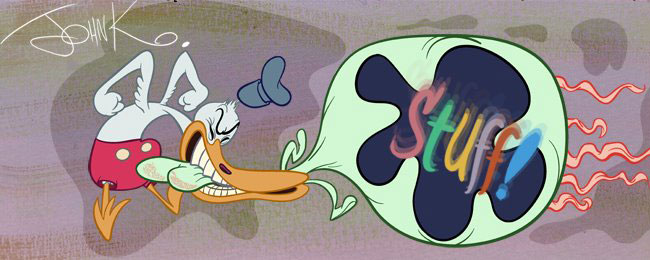
Kelly has done a very careful study of the principles in this classic comic book cover. She slowly constructed the whole image, used perspective lines and put her drawing together logically - which is very different than just drawing straight ahead starting at one side of the drawing and working your way to the other. Her drawing shows me that she is thinking, not just blindly copying.

 I think her copy is excellent and I just have some minor nitpicks and tweaks that will hopefully help her (and you) in her next studies.
I think her copy is excellent and I just have some minor nitpicks and tweaks that will hopefully help her (and you) in her next studies. When copying, I look at all the negative spaces in a picture. These spaces help tell me if I have done something wrong or not got the proportions or line of action right. Negative spaces are just as important as positive spaces. You can see that some of Kelly's negative spaces are less contrasty than the original. That means she has toned down the contrasts in the proportions and directions of the comic cover somewhat. The copy is less of a direct statement than the original.
When copying, I look at all the negative spaces in a picture. These spaces help tell me if I have done something wrong or not got the proportions or line of action right. Negative spaces are just as important as positive spaces. You can see that some of Kelly's negative spaces are less contrasty than the original. That means she has toned down the contrasts in the proportions and directions of the comic cover somewhat. The copy is less of a direct statement than the original. Bugs has a tricky head shape. It's not an oval. The front of his face is two curved angles that tend to point towards his nose.
Bugs has a tricky head shape. It's not an oval. The front of his face is two curved angles that tend to point towards his nose.When drawing an object that crosses a form, make sure the lines on either side of the crossing object aim at each other to complete the underlying form. Like Porky's ear.

Kelly's lines of action have been slightly compressed or toned down. Also, pull your characters along the line of action. The more stretched the body becomes, the less bulges will stick out along the line of action.
Porky is staring perpendicular to the page in the comic, but is looking up in the copy.
 Here's Kali's copy that is also pretty good but could benefit from a couple tips and refreshed explanations of principles.
Here's Kali's copy that is also pretty good but could benefit from a couple tips and refreshed explanations of principles.
I'll do Kali's next...
The point of studying principles by copying specific pictures:
It's not to be able to redraw the particular picture from memory. It's to understand the how and why of the picture so that you can APPLY THE SAME PRINCIPLES TO YOUR OWN DRAWINGS AT WILL.
These principles are the commonalities of all the good pictures I post. Each picture is a different specific illustration of course. What they have in common are drawing tools, skills and principles. Where they differ is in the subject matter and the story and what the characters are doing.
The best artists are the ones who understand underlying concepts and are able to use them in their own work. Weak artists copy a few superficial traits of other artists and use them every time in every instance and can't create variations and new instances or ideas out of their own skulls.
Some artists are very good at copying pictures or life models, but can't draw anything on their own. That's because they are using their eyes alone and not their brains.

